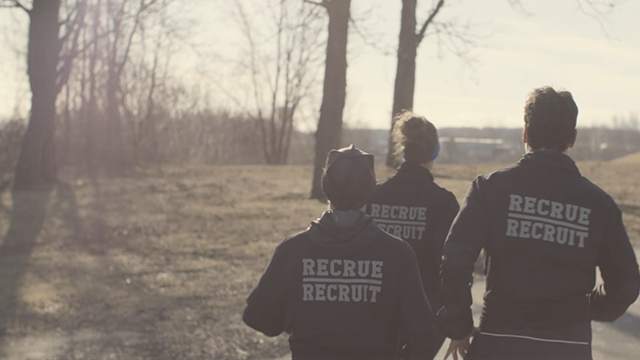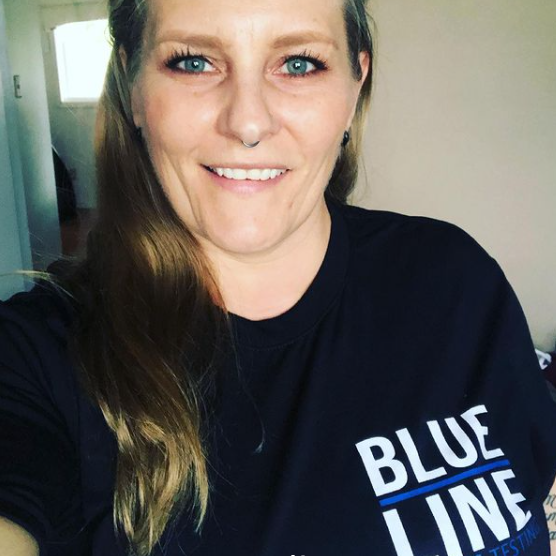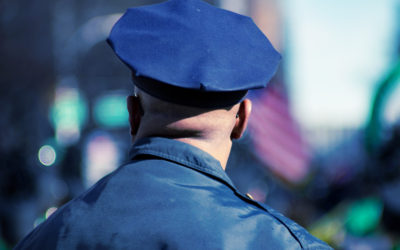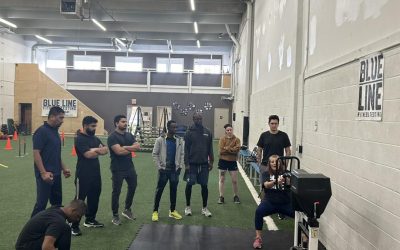Are you interested in a career as a Canadian Border Services Agent? This blog will break down every step of the application process and how you can be successful in your application. Blue Line Fitness Testing is here to help you every step of the way.
There are 5 steps to becoming a border services officer:
Step 1: Prerequisites to apply
- Be a minimum of 18 years of age. There is no maximum age limit to apply to the Canada Border Services Agency (CBSA)
- You must have Canadian citizenship or permanent residency
- Possess a Canadian secondary school (high school) diploma or equivalent
- Possess a valid, unrestricted Canadian driver’s licence
- Must be prepared to work anywhere in Canada
They accept the following as proof of education:
- A secondary school diploma;
- A satisfactory score on the Public Service Commission test* as an alternative to a secondary school diploma;
- A secondary school diploma equivalency (GED);
- A college diploma or university degree from a recognized post-secondary institution**;
- An official transcript or official letter both with an embossed seal from your institution confirming that you graduated; and;
- Foreign education credentials***.
*PRO TIP* Visit the Alternatives to education for the Qualification Standards for more information on the Public Service Commission test. Candidates who choose to provide a college diploma or a university degree as a proof of education must ensure that their credentials have been granted by a recognized or authorized post-secondary institution. Please visit the Canadian Information Centre for International Credentials website to verify that your post-secondary institution is listed as recognized or authorized. The institutions listed as registered are not recognized by the CBSA. The CBSA recognizes foreign education credentials as long as the credentials have been assessed by a member of the Alliance of Credential Evaluation Services of Canada (ACESC) and deemed comparable to Canadian standards. You must provide both the original transcript/diploma, and the foreign education credentials documents.
Important note:
the CBSA cannot accept a drivers license with provincial graduated licensing restrictions, probationary driver’s licenses and/or expired driver’s license. Anything below a class 5, 5F or G (depending on the province of residence) will not be accepted.
While the CBSA will make significant efforts to align your placement to your preferences, this may not always be possible based on operational needs. You need to fully understand and embrace the commitment you are making.

Step 2: Application process
- Apply online
- Officer Trainee Entrance Exam
- Behavioural Interview – This is a key
- Psychological assessment
- Firearms safety courses
- Medical exam
- Second language evaluation (required for bilingual positions only)
- Physical fitness evaluation
- Security clearance
Due to extensive testing required, the process can take up to 18 months.
Entrance exam
As part of the initial selection process, you must write and pass a test that assesses 4 important competencies:
- reasoning skills
- writing skills
- analytical thinking
- client orientation
The results from the exam are valid indefinitely. If you fail the exam you must wait 1 full year to re-write it. Learn more about the entrance exam and see complete sample exam questions. Blue Line Fitness Testing also offers an APCAT study guide that can help you prepare for this exam.
Interview
You must provide proof of all prerequisites during this step of the selection process. To avoid delays in your candidacy, we highly recommend that you have your documents ready before you apply.
After passing the exam, you will be invited to an interview to assess the following competencies:
- dealing with difficult situations
- decisiveness
- effective interactive communication
- judgment
- personal integrity
- values and ethics
Blue Line Fitness Testing is a leader in law enforcement interview preparation. We have several interview preparation packages and resources that can help you ace your interview. Check out these blog posts for additional tips on how to best prepare for your interivew.
Psychological assessment
The psychological assessment evaluates your ability to deal with stress and helps determine if you are suited to take the duty firearms course, which is a condition of employment. The assessment is administered by clinical psychologists in designated offices across Canada. It includes 2 exams and a face-to-face interview. Results are valid for 2 years.
Firearms safety courses
Before being invited to begin training at the Canada Border Services College, you must complete and pass the Canadian Firearms Safety Course (CFSC) and the Canadian Restricted Firearms Safety Course (CRFSC) tests. You do not need a possession and acquisition license. Blue Line Fitness Testing offers these courses regularly so check out our calendar to see all our available course dates.
Note that you must provide proof of successful completion of both courses for the selection process. You will be trained to use and handle a firearm, as it is a requirement of the position as a Border Services Officer.
Physical abilities evaluation
The Canada Border Services Agency (CBSA) uses the new self-evaluation tool and the Physical Abilities Test (PAT) to assess your physical fitness and your ability to perform physically demanding “use of force training.” The PAT will be performed during the Officer Induction Training Program (OITP) in-residence training and is not a pass or fail exercise but simply an evaluation of your level of fitness. If you fall below the minimum standards of the test, your risk of failure or injury in the program increases. Blue Line Fitness Testing offers weekly classes and monthly workshops on the PAT to ensure you fitness level is where it needs to be to pass this assessment.
This section offers comprehensive information about how to self-evaluate your fitness, the PAT and how to prepare. The three physical fitness components of the PAT are:
- Physical control
- Ground defence
- Agility drill
Physical control
One physical control task is included, the push pull sled, which was developed based on an “apprehension or restraint of a suspect using a physical control scenario”. The minimum weight standard for the sled was determined in a study aimed at identifying the amount of force required to push and/or pull the most likely suspect to resist arrest (and require an intervention that leads to the ground) off-balance and into a vulnerable position where a takedown can be effectively completed (i.e., 37 kg of force). Recruits will push and pull a weighted sled through a triangular formation once in the beginning of the test and another at the end.
Ground defence
A ground defence component is included in which simulated ground movements must be completed using a sandbag that represents the relative weight of a torso for the average Canadian adult (i.e., 36 kg). Recruits will transfer a weighted sandbag from one side of the mat to the opposite side while lying on their back. Two sets of this movement will be completed at the beginning of the test and again at the end.
Agility drill
A modified version of the Illinois Agility Test is included and aims to evaluate an individual’s ability to move quickly and assertively in different directions. This last component represents the agility/mobility and power necessary to effectively perform the high-intensity movements required during the “use of force training”, such as strikes, kicking, punching, dodging, blocking and others.
Medical exam
A physician designated by Health Canada completes an Occupational Health Assessment Report. This Category III assessment evaluates your physical ability to perform the duties of a border services officer.
You must meet the following vision and hearing standards:
- vision: corrected vision 6/9 in the better eye and 6/15 in the other eye
- hearing: no more than a 25 decibel loss (in the better ear) at a range between 500 and 3,000 hertz
The doctor’s decision determines if you are able to undergo “use of force” training and perform the physical duties of a border services officer. Results are valid for 2 years (certain conditions apply).
Second language evaluation (required for bilingual positions only)
Bilingual positions require a working knowledge of both official languages (French and English). To qualify, you must be able to speak, read, and write in your second official language at the intermediate level (BBB).
The Public Service Commission offers resources to help you prepare for second-language evaluation.
If you have previously completed the testing, we will provide instructions on how to submit your results.
Security clearance
Due to the enforcement role of the CBSA, and the sensitive nature of the work that border services officers do, candidates must obtain an Enhanced Reliability Status plus Secret Clearance as part of the selection process and maintain their clearance throughout their employment within the agency.
To obtain a security clearance, candidates must consent to a telephone integrity interview, a credit check, and law enforcement and security database verifications. Candidates must also submit the following:
- digital fingerprints (at your expense)
- a form that includes information about your:
- employment history
- qualifications
- references
- travel outside of Canada
Once all of these steps have been successfully completed, you will move forward in the process. The following steps will be required once you have been given a tentative job offer.

Step 3: Self-paced, online training modules (weekly allowance)
Officer Induction Training Program: 4 weeks to complete this training at your own pace from home. A strong internet connection and access to the web is required,
Step 4: In-residence training at the Canada Border Services College in Rigaud, Quebec (weekly allowance)
Officer Induction Training Program: 14 weeks spent at the College to learn the basics regarding security, physical control, search and seizure and legal requirements for this role.
Step 5: Paid on-the-job-training
Officer Induction Development Program: 12 to 18 months. This includes training with a Field Training Officer and modules that need to be completed and signed off by your supervisor.
At Blue Line Fitness Testing, we’re here to support you every step of the way.
Remember, success in your application is not just about crossing the finish line—it’s about the journey of preparation and dedication that leads you there.
Contact us today to start your journey towards your law enforcement career.
For more information on any of the law enforcement services Blue Line offers, check out these pages and posts:
THE IMPORTANCE OF BEING PREPARED: 5 TIPS FOR EXCELLING IN LAW ENFORCEMENT FITNESS TESTS
TOP 10 EXERCISES TO ACE YOUR PARE OR COPAT TEST
How the Pass the PARE in Alberta
Sirens, Slammers and Service – A podcast for first responders







